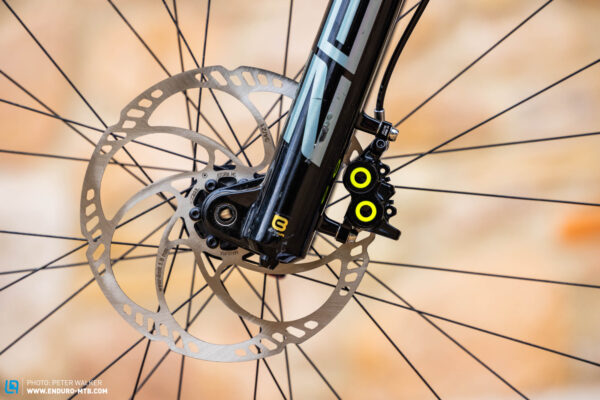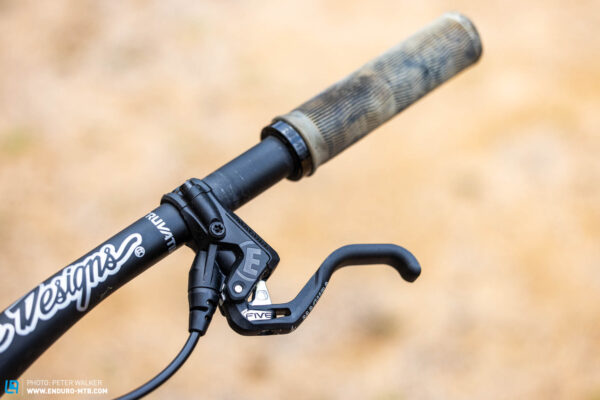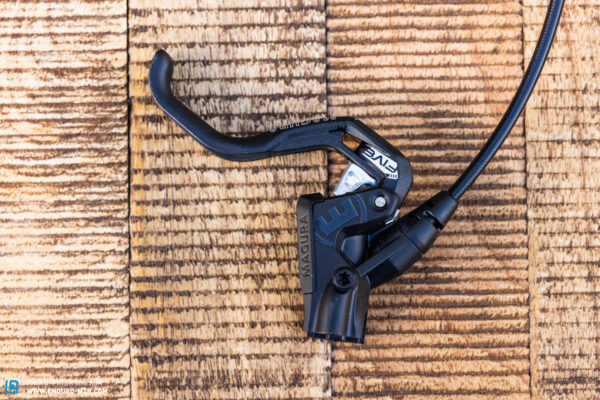The MAGURA MT5 Pro is the cheapest brake in our entire test field, and secured the coveted Best Buy in our last group test – and still costs € 300 as it did back then. But how did the plastic fantastic German stoppers fare against the 2024 test field with their Carbotecture levers?
Learn more about this comparison test: The best MTB disc brakes – 14 MTB brakes in comparison

With the MT5, German manufacturer MAGURA enter our brake comparison test with the most affordable competitor in the entire test field. Retailing at just € 299.90, the MAGURA MT5 Pro brake set also includes the rotors, which makes it an excellent choice for price-conscious buyers. MAGURA advertise it as their affordable entry-level gravity brake model. In this test, we found out whether it’s capable of br(e)aking the laws of gravity, and whether there are other benefits aside from the price.
The MAGURA MT5 Pro brake set comes standard with STORM HC rotors and ergonomic one-finger levers. For comparison’s sake, we’ve therefore deducted 2 x € 30 for the MAGURA STORM HC rotors from the set price. However, our recommendation clearly applies to the set package, as you would pay at least € 350 when buying the parts separately.


While the callipers of the MAGURA MT5 brakes consist of a single piece of forged aluminium, the levers are made of Carbotecture, which is developed and produced in-house by MAGURA in Germany and is essentially a carbon fibre-reinforced, high-tech polymer. The bolt for the bar clamp screws directly into the polymer material, resulting in a vague feeling that always makes you wonder whether you’ll damage the thread or over tighten the screw. Although MAGURA assured us that their Carbotecture material has the same tensile and breaking strength as aluminium at a lower weight, it just doesn’t seem as robust and tactile as a nice chunk of metal.
The Pro variant we tested relies on the shorter HC one-finger lever rather than the 2-finger lever found on the standard variant., Reach adjustment is via a 3 mm Allen key (rather than MAGURA’s usual T25). You won’t find the additional adjustment features you might expect from the top-tier MT7 model. Some upgrades are possible with different lever blade and pad options, but the coloured MAGURA reservoir and piston caps aren’t an option on the MT5.
The MT5 comes standard with 200 cm hoses and flip-flop levers – the levers are not side-specific, so can be run on either end of the handlebars. We found it unnecessary to bleed the brakes after shortening the hoses. If you do want to bleed them anyway for extra peace of mind, the process isn’t particularly difficult, relying on a conventional two syringe bleeding system. Inside the hoses flows MAGURA’s proprietary Royal Blood mineral oil, which might not make you a trail aristocrat, but is more environmentally friendly than DOT brake fluid.


The MAGURA MT5 Pro brakes on the trail
On the trail, the MAGURA MT5 Pros deliver a solid performance, albeit with some limitations at maximum braking force. They’re simple and intuitive to modulate but, unfortunately, lack bite towards the end of the lever stroke, thus requiring strong fingers to decelerate fast. What feels and looks better doesn’t necessarily ensure more powerful deceleration: while the one-finger lever is more ergonomic, it provides less leverage, and thus amplifies braking force to a lesser extent than a longer lever. This can result in arm pump, especially on long, steep descents. The lack of power was confirmed by our lab tests too, which puts the brake in fourth-last place in terms of braking torque, just slightly above the SRAM CODE Bronze and Ultimate models. If you want to upgrade the standard MAGURA Performance pads with Sinter’s Green pads, braking performance only increases by around 5% – on the Sinter test bench. This shows that the original pads are pretty sophisticated already. Of course, the brake levers can be replaced with longer ones to reduce the required finger force, but this would be at the expense of ergonomics and cockpit set-up. The brake is therefore particularly suitable for beginners who aren’t looking for a crazy amount of braking torque, but for good modulation and an affordable price point.
Our conclusions about the MAGURA MT5 Pro
The MAGURA MT5 Pro impresses with an all-round carefree overall package and very alluring retail price. However, braking power isn’t convincing, neither on the trail nor in the lab. The MT5 Pro requires strong fingers for comparatively little deceleration. On the bright side, it’s intuitive to modulate and easy to customise thanks to MAGURA’s tuning options.
Tops
- Decent price for the set
- Countless original accessories and upgrade parts
- Good Modulation
Flops
- Little power
- Lever reach adjustment requires tools
- Undefined thread on the handlebar clamp
For more info, visit magura.com
Find the overview of this comparison test here: The best MTB disc brakes – 14 MTB brakes in comparison
All brakes in test:
Formula Cura 4 | Hayes Dominion T4 | Hope Tech 4 V4 | MAGURA MT5 Pro | MAGURA MT7 | Shimano SLX | Shimano XT | Shimano XTR | SRAM CODE Bronze Stealth | SRAM CODE Ultimate Stealth | SRAM MAVEN Ultimate | Trickstuff MAXIMA | TRP DH-R EVO | TRP Trail EVO |
Did you enjoy this article? If so, we would be stoked if you decide to support us with a monthly contribution. By becoming a supporter of ENDURO, you will help secure a sustainable future for high-quality mountain bike journalism. Click here to learn more.
Words: Julian Schwede Photos: Peter Walker









